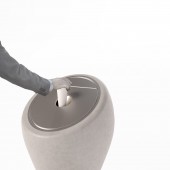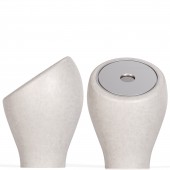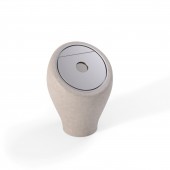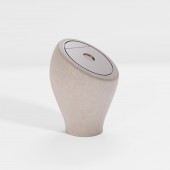
| THE AWARD |
| CATEGORIES |
| REGISTRATION |
| SUBMIT YOUR WORK |
| ENTRY INSTRUCTIONS |
| TERMS & CONDITIONS |
| PUBLICATIONS |
| DATES & FEES |
| METHODOLOGY |
| CONTACT |
| WINNERS |
| PRESS ROOM |
| GET INVOLVED |
| DESIGN PRIZE |
| DESIGN STORE |
| THE AWARD | JURY | CATEGORIES | REGISTRATION | PRESS | WINNERS | PUBLICATIONS | ENTRY INSTRUCTIONS |
Pithos Public Trash Can by Nikolaos Baskozos |
Home > Winners > Design #78698 >Interview |
 |
|
FS: What is the main principle, idea and inspiration behind your design?
NB: This concept is part of a design series that consist an ongoing work in progress regarding street furniture with abstract, primitive forms. This particular design refers to the form of a pithos, an ancient Greek terracotta jar.
FS: What are your future plans for this award winning design?
NB: To publicize it and ideally sell or lease the rights to a company that will eventually produce it.
FS: Why did you design this particular concept? Was this design commissioned or did you decide to pursuit an inspiration?
NB: It was a pursuit of inspiration. It is a part of an ongoing project which made its first entry for the Pan-Hellenic Street Furniture Competition for the Dodecanese Islands (2018). It’s evolution led to a series of street furniture designs.
FS: Is your design being produced or used by another company, or do you plan to sell or lease the production rights or do you intent to produce your work yourself?
NB: This design is not being produced or used by another company. My intension and ambition is to collaborate with a company to produce it.
FS: What made you design this particular type of work?
NB: A desire to explore a traditional form, and to reuse it with an analogy to it’s initial properties. An ancient terracotta jar was used for storing food or other things, while a trash can is also a temporary storage space for litter.
FS: Where there any other designs and/or designers that helped the influence the design of your work?
NB: The Spanish company “Escofet” has a great collection of works fabricated with the same material, so I would say that their collection is a loose inspiration.
FS: Who is the target customer for his design?
NB: Companies that could fit this design in their collection.
FS: How did you come up with the name for this design? What does it mean?
NB: “Pithos” (/ˈpɪθɒs/,[1] Greek: πίθος, plural: pithoi πίθοι) is is the Greek name of a large ceramic storage container which is the main inspiration behind this design.
FS: Which design tools did you use when you were working on this project?
NB: Hand drawing for initial sketches of the idea, 3d software for working on the idea and presenting it.
FS: What is the most unique aspect of your design?
NB: The reference to the historic form of a pithos is fairly apparent, though it is not a copy of it. It feels as something familiar, but at the same time it is not. It generates and intrigues a memory.
FS: What is the role of technology in this particular design?
NB: Fiber reinforced cementitious mortar makes the realization of designs like this possible because it has a ceramic quality. It provides high mechanical and aesthetic performance in small thicknesses.
FS: Is your design influenced by data or analytical research in any way? What kind of research did you conduct for making this design?
NB: I was mostly influenced by ancient Greek vernacular forms, while looking for an appropriate form for a contemporary bin.
FS: What are some of the challenges you faced during the design/realization of your concept?
NB: The biggest challenge was to find an appropriate vernacular form for a contemporary bin and to achieve with it a triggering of a memory recollection and not a mere replication.
FS: How did you decide to submit your design to an international design competition?
NB: Having technical and financial obstacles for its fabrication, I considered submitting “Pithos” as an opportunity to communicate it and publicize it as a 3d visualization. Hopefully that would lead to a collaboration with a company that has the means to produce it.
FS: What did you learn or how did you improve yourself during the designing of this work?
NB: My interest in furniture design grew even further because I realized that I could materialize ideas in an abstract manner, without having to worry so much about the technical and legal aspects of architecture.
FS: Thank you for providing us with this opportunity to interview you.
A' Design Award and Competitions grants rights to press members and bloggers to use parts of this interview. This interview is provided as it is; DesignPRWire and A' Design Award and Competitions cannot be held responsible for the answers given by participating designers.
| SOCIAL |
| + Add to Likes / Favorites | Send to My Email | Comment | View Press-Release |





